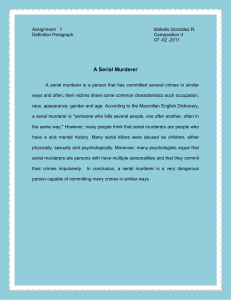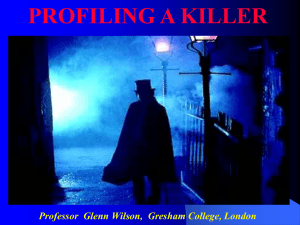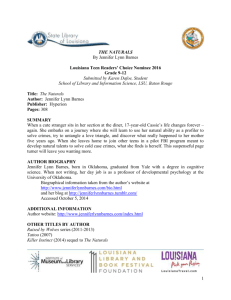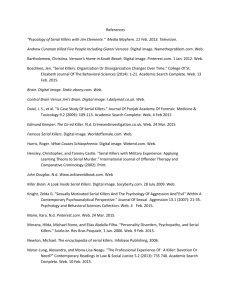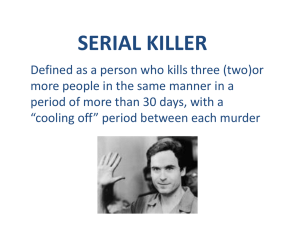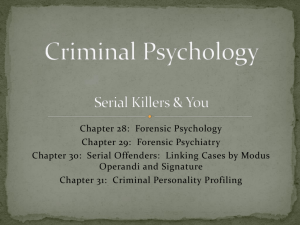Word Count: 2083 Thomas Blankenship 6 April 2000
advertisement
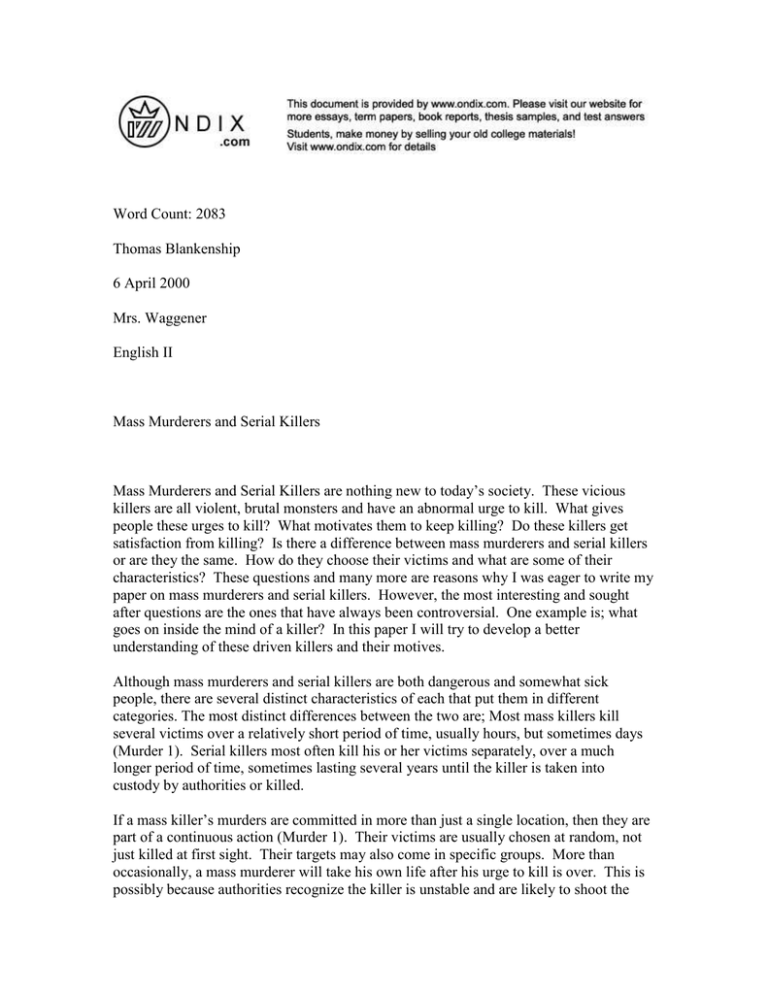
Word Count: 2083 Thomas Blankenship 6 April 2000 Mrs. Waggener English II Mass Murderers and Serial Killers Mass Murderers and Serial Killers are nothing new to today’s society. These vicious killers are all violent, brutal monsters and have an abnormal urge to kill. What gives people these urges to kill? What motivates them to keep killing? Do these killers get satisfaction from killing? Is there a difference between mass murderers and serial killers or are they the same. How do they choose their victims and what are some of their characteristics? These questions and many more are reasons why I was eager to write my paper on mass murderers and serial killers. However, the most interesting and sought after questions are the ones that have always been controversial. One example is; what goes on inside the mind of a killer? In this paper I will try to develop a better understanding of these driven killers and their motives. Although mass murderers and serial killers are both dangerous and somewhat sick people, there are several distinct characteristics of each that put them in different categories. The most distinct differences between the two are; Most mass killers kill several victims over a relatively short period of time, usually hours, but sometimes days (Murder 1). Serial killers most often kill his or her victims separately, over a much longer period of time, sometimes lasting several years until the killer is taken into custody by authorities or killed. If a mass killer’s murders are committed in more than just a single location, then they are part of a continuous action (Murder 1). Their victims are usually chosen at random, not just killed at first sight. Their targets may also come in specific groups. More than occasionally, a mass murderer will take his own life after his urge to kill is over. This is possibly because authorities recognize the killer is unstable and are likely to shoot the killer in order to protect themselves. A typical mass murderer uses a semi-automatic weapon and plots his murders to be made in a school, university, or restaurant (murder 1). Serial killers commonly attack a single target at a time one on one. There also tends to be no or very little relation between the person being killed and the killer (murder 1). “The nature of this drive has been heavily debated, but there is a consensus on some points (Anderson 1).” Many researchers have noted sexual behavior in the murder. This point was first introduced twenty years ago by David Abrahamson. More recently, this was qualified by Albert Drukteinis who recognized that “the sexual element of the crime varies depending on its meaning to the offender” (Anderson 1). This means, whatever trademarks womanhood may differ between killers. At the same time, similarities in the acts and thoughts of serial killers cannot be denied. “These sexual undertones are one of the more prominent difference, and have inspired several researchers to refer to the selfmotivated serial murderer as a serial sexual murderer” (Anderson 1). “Although there may be a “pattern” or “victim” trait, individual murders within a series rarely display a clearly defined or rational motive.” (Murder 1) With the invention of the automobile many years ago, there has been a growing increase in serial killings. This is due to the fact that an automobile enables the killers to move quickly and unnoticed from one place to another before the murder is discovered. When a serial killer kills, there is often a high level of over brutality meaning the killer tends to do more than kill the victim; such as putting them through unnecessary pain. The last and possibly one of the most unique characteristics of a serial killer is their choice to stab or strangle their victims. In an article off of the Mass Murder Web Site titled “Murder Characteristics”, many of these characteristics were described. Mass Killers usually attack schools, universities and restaurants believing it to be a place for a maximum kill effect, usually striking with a semi-automatic weapon and wearing camouflage gear, they attempt to kill all they see and their rampage usually ends with them committing suicide or being killed/captured by police. Serial killers are different. They can usually go up to years without being caught and when they are caught its usually by the weight of evidence against them, or sometimes they can get caught by chance like the Yorkshire Ripper. They prefer to stab or strangle their victims and sometimes strangle them like David Berkoitze. They sometimes leave trophies or leave trademarks of their crimes. Some Serial Killers prefer to rape their victims before they kill them, like Ted Bundy or Dean Corll (Murder 2) If someone brutally and abundantly kills several people in a single episode, they would be most likely labeled as a mass murderer. As modern as mass murders may seem, they are not. However, they are rapidly becoming more popular by the day. “These lethal crimes are increasingly common. Mass murder is not a twentieth century phenomenon, but theorist believe that break down in social contracts during the past three or four decades undermined the inhibitions that ordinarily keep a person from acting on impulses to kill” (True Crime: Mass 3). A mass murder is often triggered by en event that may or may not be related to the killer’s real problems. They often store many of the disappointments, grievances, and frustrations inside until one incident makes them explode with violent rage (True Crime: Mass 6). After carrying a burden of the many elements of anger and sadness that keep inside, he or she reacts like a bomb setting out for the people the murderer blames for this burden. Most serial killers are white males between the ages of 25 and 35 years old with an intelligence level of average or higher. They also tend to be married with children and have a career (Serial 1). They also seem to have a childhood past of being physically and sexually abused and are from broken homes. As children, they often wet the bed, were infatuated with masturbation, were cruel to animals, and liked playing with fire. Because of their childhood, they often develop a psychopathic nature and do not know how to feel sympathy or be in a relationship (Scott 2). Because of their insecurity, a compulsive need to feel like they are in authority becomes a vital part of their well-being, even at the cost of others lives. As Americans look back at the past one hundred years, we stand in awe while looking at the drastic increase in crime. However, at the same time we have a hunger for knowledge of these crimes as we search for and interesting theory. People want to know every detail of the most brutal crimes, and moreover, how they were committed. Angie cannon insists that this is because people want to believe that it cannot happen to themselves. “We want to know how these unspeakable acts were committed, to convince ourselves that we are immune from the same wretched fait (Cannon 1).” Lee Ross also states a similar theory, which indicates that “Every suicide is unconsciously a suicide and every suicide is, in a sense, a psychological homicide” (Ross 1). Although many of these murderers kill out of hate and anger, many kill out of love and passion. The editors of Time Magazine quoted; Love is a risky business, there are no guarantees that it won’t turn sour or die, nor is their any insurance to protect against cooling passion, broken vows, deceit, or desertion. Most people who have been rejected by a lover or spurred by a spouse, although their heartbreak and humiliation, eventually get on with life. For a few, however, the injured lover’s emotion turns inside out and takes on lethal proportions. The price expected for betrayal is death, in some cases from faithless partners, in others from an unsurprising rival. However the victim, a crime of passion is a reverse act of devotion, a murderous testament to the killers depth of feeling that is as powerful as any declaration of love (True Crime: Passion 79). Crimes of passion are a perfect example of insecurity. These killers who commit these crimes seem to turn against their lover because they feel like their lover hurt he or she intentionally. The killer does not understand how someone they cared about so much could turn on them. This passion becomes frustration and hate takes over, the killer fills that killing the perpetrator will bring him ease the pain. However, murders of passion, along with any other murder, can also be linked to their biology. Killers are characterized individually, each with unique motives, which are possibly shaped not only by their past but also by biology. Criminal behavior “is likely to operate through individual difference in intelligence, personality, and mental disorder, all of longstanding as explanations of criminal behavior, and all of which are known to have a simple genetic component”(Feldman 134). This theory does not state that criminals kill because of their biological characteristics, but that many of the characteristics of a killer can be linked to biology. The magnitude of how humanity can become dangerous brutal outlaws can be catalogued into one of two broad divisions, social environmental and bio-physiological (Athens 1). This theory does not mean that the reason for someone to become a killer is based completely on environmental or biological factors. This theory is based on the belief that “classification rests only on the presumption that in all theories, one kind of factor is invariably emphasized” (Athens 1). This means that environmental and biological factors can both influence people to kill. Mass murderers and serial killers are the most dangerous and brutal killers around. There are many theories that influence criminologist and psychologist alike in determining what drives these killers. They research the many factors such as genetics, society, childhood, and even the need for security and love in hope of discovering why people become killers. As these people attempt to unscramble these factors and look at other possibilities, the rest of the world watches in hopes of an answer that may never be found.Bibliography Page Thomas Blankenship 4/6/00 English II Mrs. Waggener Athens, Lonnie H. The Creation of Dangerous Violent Criminals. London: Routledge, 1992. This book explains a theory that brutal action is a Composite experience that comes from three different elements. Anderson, Jeremy. Genesis of a Serial Killer. Decorah: Illinois, 1993. Http: //www.Genesis/killer.com/stud/luther.html This article is from a student at Luther College who is in the psycholigy department analyzing research on serial killers. Cannon, Angie. “The Awful Acts of the Past One Hundred Years Forced America To Look At Itself In The Mirror.” U.S. News & World Report. Vol. 127 (1999) 41-51. This article talks about how America looks down on crime but at the same time clings to every detail. Feldman, Philip. The Psychology of Crime. New York, NY: Cambridge University Press, 1993. This Book explains how genetics can and cannot be related to violent crimes. “Murder Characteristics.” Mass Murder Website. Feb. 2000. Http://www.fortunecity.com/roswell/hammer/73/murderer.html (21 Mach 2000) This article explains the difference between mass killers and serial killers. Ross, Lee E. “Mass Murder, Suicide, and Moral Development: Can We Separate The Adults From the Juveniles?” International Journal of Offender Therapy And Comparitive Criminology. Vol. 43 (1999) 8-20. This article talks about mass murders of teens and adults. Scott, Shirley Lynn. “What Makes Killers Tick” Crime Library. June 2000. http://www.crimelibrary/serials/what/whatmain/htm. (21 march 2000) describes the possible urges that many murderers may feel influencing them to kill. “Serial Killer Characteristics” Serial Killer Exposed. May 99. http;//www.memberw.tripod.com/serialkillr/serial killers exposed/Index.htm. (21 March 2000) This article talks describes a few of the statistics of mass killers. True Crime: Crimes of Passion. eds. Time Life Books. Alexandria virginia:1994 This article explains how love also comes with deciet and anger which often triggers people to kill. True Crime: Mass Murderers. eds. Time Life Books. Alexandria Virginia: 1992 This journal article explains the common profile of a mass murderer and some of their common characteristics. Keywords: word count thomas blankenship april waggener english mass murderers serial killers mass murderers serial killers nothing today society these vicious killers violent brutal monsters have abnormal urge kill what gives people these urges kill what motivates them keep killing these satisfaction from killing there difference between mass murderers serial they same they choose their victims what some their characteristics questions many more reasons eager write paper however most interesting sought after questions ones that have always been controversial example goes inside mind killer this paper will develop better understanding driven their motives although both dangerous somewhat sick people there several distinct characteristics each that them different categories most distinct differences between most kill several victims over relatively short period time usually hours sometimes days murder often victims separately over much longer period time sometimes lasting several years until killer taken into custody authorities killed killer murders committed more than just single location then they part continuous action murder usually chosen random just killed first sight targets also come specific groups more than occasionally murderer will take life after urge over this possibly because authorities recognize unstable likely shoot order protect themselves typical murderer uses semi automatic weapon plots murders made school university restaurant murder commonly attack single target time there also tends very little relation between person being killed nature this drive been heavily debated consensus some points anderson many researchers have noted sexual behavior point first introduced twenty years david abrahamson recently qualified albert drukteinis recognized that sexual element crime varies depending meaning offender anderson means whatever trademarks womanhood differ same similarities acts thoughts cannot denied sexual undertones prominent difference inspired researchers refer self motivated murderer anderson although pattern victim trait individual murders within series rarely display clearly defined rational motive with invention automobile many years been growing increase killings fact automobile enables move quickly unnoticed from place another before discovered when kills often high level brutality meaning tends than victim such putting them through unnecessary pain last possibly unique characteristics choice stab strangle article site titled were described usually attack schools universities restaurants believing place maximum effect striking with semi automatic weapon wearing camouflage gear attempt rampage ends with committing suicide being captured police different without being caught when caught weight evidence against sometimes caught chance like yorkshire ripper prefer stab strangle strangle like david berkoitze leave trophies leave trademarks crimes some prefer rape before like bundy dean corll someone brutally abundantly kills people single episode would likely labeled modern seem however rapidly becoming popular lethal crimes increasingly common twentieth century phenomenon theorist believe break down social contracts during past three four decades undermined inhibitions ordinarily keep person from acting impulses true crime often triggered event related real problems store disappointments grievances frustrations inside until incident makes explode violent rage true crime after carrying burden elements anger sadness keep inside reacts bomb setting blames burden white males ages intelligence level average higher also tend married children career seem childhood past physically sexually abused broken homes children were infatuated masturbation were cruel animals liked playing fire because childhood develop psychopathic nature know feel sympathy relationship scott because insecurity compulsive need feel authority becomes vital part well even cost others lives americans look back past hundred stand while looking drastic increase however same hunger knowledge crimes search interesting theory want know every detail brutal moreover committed angie cannon insists want believe cannot happen themselves want know unspeakable acts committed convince ourselves immune wretched fait cannon ross states similar theory which indicates every suicide unconsciously suicide every sense psychological homicide ross although hate anger love passion editors magazine quoted love risky business guarantees turn sour insurance protect against cooling passion broken vows deceit desertion rejected lover spurred spouse heartbreak humiliation eventually life injured lover emotion turns takes lethal proportions price expected betrayal death cases faithless partners others unsurprising rival victim passion reverse devotion murderous testament depth feeling powerful declaration love true perfect example insecurity commit seem turn against lover feel hurt intentionally does understand someone cared about much could turn becomes frustration hate takes fills killing perpetrator will bring ease pain along other linked biology characterized individually each unique motives which possibly shaped only biology criminal behavior likely operate through individual difference intelligence personality mental disorder long standing explanations criminal behavior which known simple genetic component feldman theory does state criminals biological linked biology magnitude humanity become dangerous brutal outlaws catalogued into broad divisions social environmental physiological athens does mean reason someone become based completely environmental biological factors based belief classification rests only presumption theories kind factor invariably emphasized athens means environmental biological factors both influence dangerous around theories influence criminologist psychologist alike determining drives research factors such genetics society childhood even need security hope discovering become attempt unscramble look other possibilities rest world watches hopes answer never found bibliography page thomas blankenship english waggener athens lonnie creation violent criminals london routledge book explains action composite experience comes three different elements jeremy genesis decorah illinois http genesis stud luther html article student luther college psycholigy department analyzing research cannon angie awful acts hundred forced america look itself mirror news world report article talks about america looks down clings detail feldman philip psychology york cambridge university press book explains genetics cannot related website http fortunecity roswell hammer html mach explains ross moral development separate adults juveniles international journal offender therapy comparitive criminology talks about teens adults scott shirley lynn makes tick library june http crimelibrary serials whatmain march describes possible urges influencing exposed memberw tripod serialkillr exposed index march talks describes statistics life books alexandria virginia comes deciet anger triggers books alexandria virginia journal common profile common Keywords General: Essay, essays, termpaper, term paper, termpapers, term papers, book reports, study, college, thesis, dessertation, test answers, free research, book research, study help, download essay, download term papers

